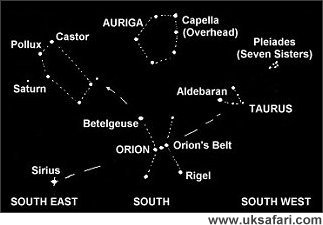
|

|
|
 Sent
to you Sent
to you
by e-mail
|
|
Simply
enter your details and hit the send button
more
info |
|


Click Here

Links
Advertise
Terms of Use
Contributors
About Us
Contact Us
|
 |
Go back
 | Bookmark
| Bookmark
 | Print Page
| Print Page  | E-Mail Us
| E-Mail Us 
Astronomy - The Night Sky in Winter
by Colin Ebdon
The night sky in winter is a fine sight from the U.K. At first, it may seem just a jumble of stars, but by using the main constellation of Orion (The Hunter) as a signpost, it will soon resolve into recognisable patterns which will become as familiar as the landscape around your home (see
below).

By mid-evening in December, Orion can easily be found by looking South and finding the three stars in a line which make up his ‘belt’. His top left hand shoulder is marked by the bright reddish star Betelgeuse and his bottom right foot by the bright white star
Rigel.
Follow his ‘belt’ of three stars upwards and you will eventually come to the orange star Aldebaran marking the ‘eye’ of Taurus, the bull. A bit further on and a little higher, you may notice from the corner of your eye a misty patch of faint stars in a tiny group. These form the Pleiades otherwise known as the ‘Seven Sisters’.
By following Orion’s belt downwards in the other direction, towards the South East horizon, you will find the brilliant start Sirius, the brightest star visible from Britain flashing like a jewel low in the sky. Sirius is in the constellation of Canis Major the Great Dog, and it is often known as the ‘Dog Star’. In the summer months, Sirius is in the sky in daytime, because by then the sun has moved nearby. This fact was known to the ancient Egyptians, who thought that the brilliant Sirius must add to the overall power of the sun. This resulted in particularly hot, sultry days becoming known as the ‘Dog Days’ of summer.
Take a line upwards from Orion’s belt, through Betelgeuse top left and you will eventually come to a pair of stars of similar brightness. These are Castor and Pollux in the constellation of the twins, Gemini. In 2004 they are joined by the Planet Saturn shining with a steady, yellowish light.
Unfortunately, the rings of Saturn are not visible without the aid of an astronomical telescope, but there is plenty to see with field binoculars. Point them at the Pleiades and instead of a cluster of seven stars, you will see dozens more. Point your binoculars below Orion’s Belt and you may see a group of stars embedded in a hazy patch of light. This marks the great Orion Nebula, which is really a gigantic gas cloud and the birthplace of new stars.
For those viewing with the naked eye, why not look out for the Geminid Meteor shower, one of the more reliable showers of ‘shooting stars’. This year, the Geminids shower should reach its peak on the evening of December 13. The meteors appear to emanate from the region of Gemini, but will whizz across the sky in all directions. Make sure that you are warm and comfortable, look up in the sky towards the South East, and you will be unlucky not to see one or two within ten minutes or so.

More websites about astronomy
|
 |

|